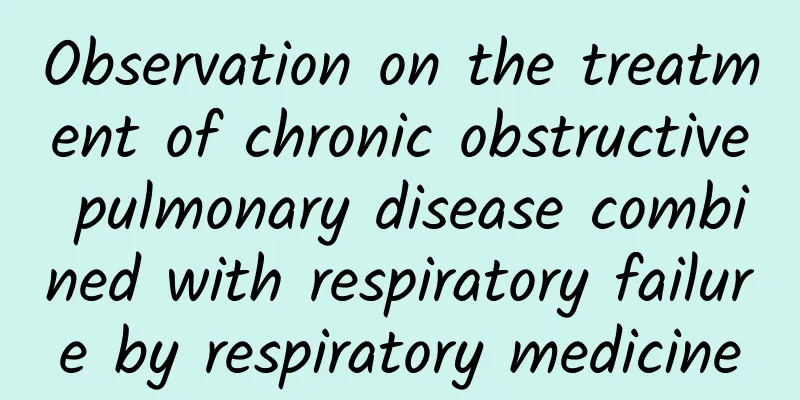Observation on the treatment of chronic obstructive pulmonary disease combined with respiratory failure by respiratory medicine

|
1. Understanding Chronic Obstructive Pulmonary Disease Chronic obstructive pulmonary disease (COPD) is a common chronic respiratory disease. Its main feature is persistent airflow limitation, which is related to the abnormal inflammatory response of the lungs to harmful particles or gases. The course of COPD is usually progressive and irreversible. Globally, the morbidity and mortality of COPD are high, which has a serious impact on patients' daily life and work. 2 Chronic obstructive pulmonary disease and respiratory failure Respiratory failure is a common complication of COPD. When the lung function of COPD patients is severely impaired and cannot meet the body's demand for oxygen, or the expelled carbon dioxide cannot be effectively removed, respiratory failure will occur. Patients may experience symptoms such as hypoxia, carbon dioxide retention, and dyspnea, which can be life-threatening in severe cases. 3 Treatment methods in respiratory medicine 3.1 Drug treatment: For patients with COPD and respiratory failure, drug treatment is the basis. Commonly used drugs include bronchodilators (such as salbutamol, terbutaline, etc.), glucocorticoids and theophylline drugs. These drugs can relax airway smooth muscle, reduce airway inflammation and relieve symptoms. 3.2 Oxygen therapy: For patients with obvious hypoxia, doctors will recommend oxygen therapy. By inhaling oxygen, the oxygen concentration in the blood can be increased to meet the body's demand for oxygen. 3.3 Non-invasive mechanical ventilation: Non-invasive mechanical ventilation is an important treatment for patients with moderate to severe COPD and respiratory failure. Through a mask or nasal mask connected to a ventilator, the patient can breathe with the help of the ventilator, thereby improving hypoxia and carbon dioxide retention. 3.4 Invasive mechanical ventilation: When non-invasive mechanical ventilation cannot meet the patient's needs, invasive mechanical ventilation may be required. At this time, it is necessary to connect the ventilator through endotracheal intubation or tracheotomy to provide respiratory support for the patient. 4 Observation and care during treatment 4.1 Observe changes in the patient's condition: During the treatment process, medical staff need to closely observe changes in the patient's condition, including respiratory rate, heart rate, blood pressure, blood oxygen saturation, etc. These indicators can reflect the patient's respiratory function and degree of hypoxia. 4.2 Adjust the treatment plan: According to the changes in the patient's condition and the treatment effect, medical staff need to adjust the treatment plan in a timely manner. For example, adjust the dosage of the drug, change the method of oxygen therapy, adjust the parameters of the ventilator, etc. 4.3 Respiratory care: Maintaining a patency of the respiratory tract is crucial for patients with COPD and respiratory failure. Medical staff need to regularly clear the respiratory tract for patients to prevent sputum accumulation. At the same time, it is also very important to teach patients the correct coughing and expectoration techniques. 4.4 Psychological support: COPD patients with respiratory failure often suffer from psychological problems such as anxiety and depression due to the long course of the disease and repeated attacks. Medical staff need to pay attention to the patient's mental state, provide necessary psychological support, and help patients build confidence in overcoming the disease. 4.5 Lifestyle guidance: Good lifestyle habits can help control the condition of COPD and prevent the onset of respiratory failure. Medical staff should guide patients to quit smoking, maintain a good work and rest schedule, do appropriate exercise, and increase nutritional intake. 4.6 Prevent infection: Infection is one of the common causes of COPD patients and an important cause of respiratory failure. Therefore, infection prevention is crucial. Medical staff should educate patients to keep warm, strengthen their own immunity, reduce contact with infection sources and other measures to reduce the risk of infection. 5 preventive measures in daily life 5.1 Quitting smoking: Quitting smoking is one of the most important measures to prevent COPD and respiratory failure. Quitting smoking can significantly improve lung function, slow the progression of COPD, and reduce the risk of respiratory failure. 5.2 Healthy diet: Maintaining a balanced diet, increasing the intake of vegetables and fruits, and reducing high-fat, high-calorie foods will help improve the body's immunity and prevent infection. 5.3 Improve physical fitness: Appropriate exercise can enhance the body's resistance and improve lung function. It is recommended to choose appropriate exercise according to your own situation, such as walking, jogging, Tai Chi, etc. 5.4 Regular check-ups: For COPD patients, regular lung function tests can help monitor the progression of the disease and promptly detect and treat complications. If there are any concerns or symptoms worsen, seek medical attention as soon as possible. Through observations of respiratory medicine treatment for chronic obstructive pulmonary disease combined with respiratory failure, we can see that effective treatment plans and meticulous care are essential to improving patients' quality of life and prognosis. In life, quitting smoking, eating a healthy diet, strengthening physical fitness, and regular check-ups are key measures to prevent and delay the progression of the disease. However, COPD is a complex disease, and for patients with severe conditions, timely medical treatment and professional treatment are essential. We hope that through this information, we can provide patients and medical staff with useful references to jointly cope with this common chronic disease. ( Ma Longzhi, Changji Hui Autonomous Prefecture People's Hospital, Changji City, Changji Hui Autonomous Prefecture, Xinjiang Uygur Autonomous Region) |
<<: Is it true that I can no longer speak after laryngeal cancer surgery?
>>: It hurts to the bone! You must know this information about influenza B
Recommend
How to regulate low menstrual flow, increase menstrual flow by doing this
If your menstrual flow is light, you should be al...
What is the best medicine for cervicitis?
Cervicitis is mainly caused by deficiency of Qi a...
What is the reason why the gas water heater cannot ignite? How to solve the problem that the gas water heater does not produce hot water
A gas water heater, also called a gas water heate...
What are the symptoms caused by cervical erosion?
Cervical erosion is a common gynecological diseas...
Is it really dangerous to be a vegetarian? It’s a “technical job”! Do these things to stay safe →
Ever since Liu Xiaoqing mentioned that her friend...
How to regulate menopause
Everyone knows that when women enter menopause, t...
Is it normal to have an enlarged uterus?
Many girls have no idea about uterine hypertrophy...
What to do if the milk becomes less after breast engorgement
After giving birth to a baby, many people will ex...
How to treat cold stomach in women?
Many women are afraid of cold by nature. It is no...
What are the contraindications of Chinese medicine during lactation?
I believe that many mothers who have given birth ...
Can I soak my feet while pregnant?
There are still many issues that women need to co...
Osteoporosis prevention and treatment guide: If you don’t want to be “haunted” by osteoporosis when you are old, it is recommended to read this guide
Hello everyone, October 20th of every year is Wor...
There are so many tricks to eat fruit, how many do you know? ?
Sweet, delicious and colorful fruits are the favo...
Shanghai has it too! The "red, orange, and green" reminders for supermarkets, my mom no longer has to worry about me drinking the wrong beverages!
Remember we reported not long ago that beverages ...
What are the raw materials for making glutinous rice cake? What are the benefits of eating glutinous rice cake?
Ciba tastes sweet. When you go out, you can often...









